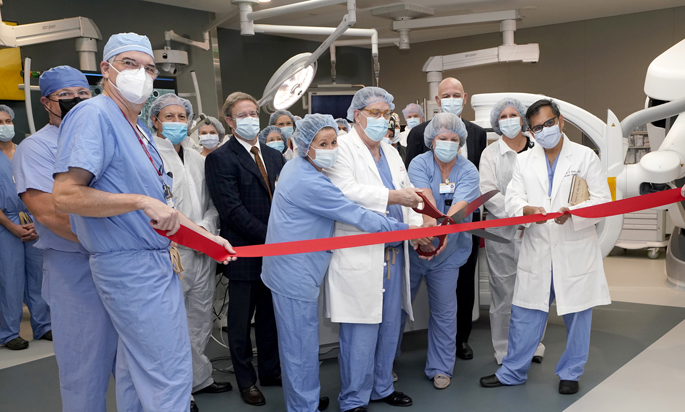
Vanderbilt University Medical Center is opening two of the latest generation of hybrid operating rooms, which each combine a traditional operating room with the latest advanced imaging equipment, simplifying procedures and allowing them to be more efficient and safer for patients.
“These two rooms not only represent a huge institutional investment of capital, but it really is philosophically an investment in the future — that we understand that Vanderbilt’s role in cardiovascular disease is to innovate, to lead and to be able to respond to future challenges,” said Ashish Shah, MD, professor and chair of Cardiac Surgery. “While the rooms themselves will allow us to take care of any patient today, we really believe they allow us to take care of patients in the future.”
The state-of-the-art operating rooms (ORs) are located on the third floor of Vanderbilt University Hospital. Though VUMC has built a handful of such rooms in recent years, these are the Medical Center’s first that will be shared by a multidisciplinary cohort. Teams performing cardiology and electrophysiology procedures as well as cardiac and vascular surgery will benefit from the sophisticated technology in the room — and from each other.
“These rooms are the brainchild of a multidisciplinary group of surgeons, physicians, nurses and administrators and are a terrific example of problem solving so that we can better meet the needs of our patients,” said C. Wright Pinson, MBA, MD, Deputy Chief Executive Officer and Chief Health System Officer for VUMC. “I want to express my appreciation to this collaborative group for their strategic approach to current and future capacity issues.”
Shon Dwyer, MBA, RN, President of Vanderbilt University Hospital (VUH), also noted the collaborative nature of the planning of the new ORs.
“The common denominator in this project is that through collaboration and partnership these teams have thought through every step of a patient’s journey,” she said.
At approximately 1,175 square feet each, the hybrid ORs are nearly double the size of traditional operating rooms and stocked with the Siemens ARTIS pheno imaging system, dominated by a large robotic arm, ready to assist in the most sophisticated procedures.
“The rooms look completely different than a normal operating room,” said Seth Karp, MD, chair of the Section of Surgical Sciences, H. William Scott Jr. Professor and director of the Vanderbilt Transplant Center. “This is the most advanced system that’s ever been created for vascular and cardiac procedures.”
The hybrid design enables minimally invasive procedures to take place in combination with traditional open surgical approaches. Meanwhile, advanced, real-time imaging allows surgeons to better monitor the procedures, allowing them to take place more efficiently.
“The rooms are going to accommodate whatever is the appropriate team for the procedure — cardiology, cardiac surgery and vascular surgery,” Karp said. “We are going to be able to use the full capacity of those rooms and treat the patient with the correct procedure and personnel.”
Patients benefit from the rooms because they allow for multiple procedures to take place on one occasion, rather than scheduling multiple surgeries on separate occasions, each requiring sedation. This allows for a shorter operative time, shorter length of stay and quicker recovery.
“We can take care of people with very conventional vascular problems, but it’s also really built to manage patients who require multiple specialties to tackle complicated aneurysms, complicated dissections,” Shah said. “And in some respects, it’s designed to handle problems that we don’t even know about that will come along in the future that will require spaces that allow different specialties to come together and to solve the problems.”
The complex logistical operation of designing and building the rooms in limited space required a multidisciplinary team, led by Barbara Sanders, BSN, RN, MMHC, associate vice president of adult perioperative services at VUH. The Planning, Construction and Design team worked diligently to design the rooms, supporting both the clinical and infrastructure needs. Building the rooms required relocating adjacent clinical space and incorporating unused shelled space, Sanders said. Building out all the technology included creating an equipment room between the two ORs to house the innovative machinery powering them.
“This was an unprecedented way of taking existing real estate and making it meet the capacity needs of four service lines,” Sanders said. “It is a creative and unique way to optimize procedural and surgical case volume expansion needs. It’s a shared, collaborative space.”












